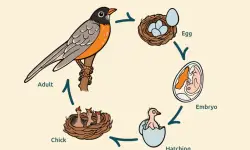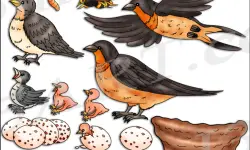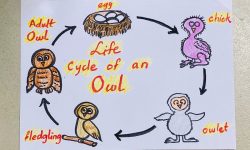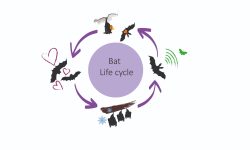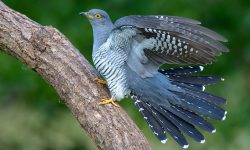Utah’s vast skies, rugged canyons, and sweeping open lands make it a perfect place to spot birds of prey—especially hawks. As someone who spends countless hours hiking, exploring remote trails, and birdwatching with binoculars in hand, I’ve come to deeply appreciate the incredible variety of hawks in Utah. Each sighting feels like a small gift from nature, whether it’s a soaring Red-tailed Hawk or a Northern Harrier gliding low over the grass.
The state is home to a surprising number of hawk species—some are year-round residents, others visit seasonally, and a few appear only rarely during migration. Regardless of when or where you go birding, there’s always a chance of spotting one of these impressive raptors. The diversity of hawks in Utah reflects the wide range of habitats here, from desert flats to alpine forests.
In this guide, I’ll walk you through 14 different hawks in Utah, complete with pictures and identification tips based on my personal observations and research. This article is for anyone who enjoys being outdoors, paying attention to the sky, and discovering the presence of these powerful and fascinating birds in the wild.
Common and Regularly Observed Hawks in Utah
Red-tailed Hawk (Buteo jamaicensis)
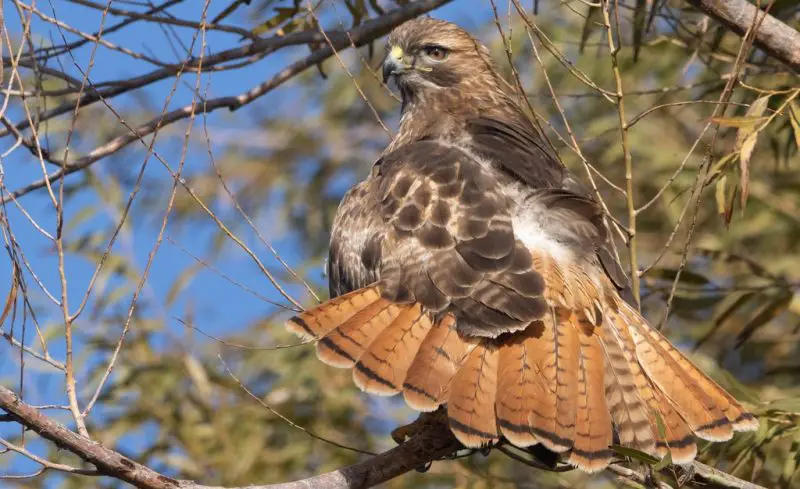
The Red-tailed Hawk is one of the most widespread and easily recognized raptors in North America. In Utah, it is the most commonly observed hawk throughout the year. It features broad, rounded wings and a short, wide tail that is often a rich, brick-red color in adults—hence its name.
Adults typically have a pale underside with a dark belly band and a streaked appearance. Juveniles lack the signature red tail and instead display more brownish-gray plumage. This species can be seen soaring above open fields, perched along highways, or circling high in thermals. Their loud, raspy scream is often used in movies as a generic “eagle” sound.
Red-tailed Hawks are present in Utah year-round, making them a familiar sight in both rural and suburban landscapes. A fun fact about them is that they often form monogamous pairs and return to the same nesting sites for several years, adding to their long-term presence in a given area.
Cooper’s Hawk (Accipiter cooperii)
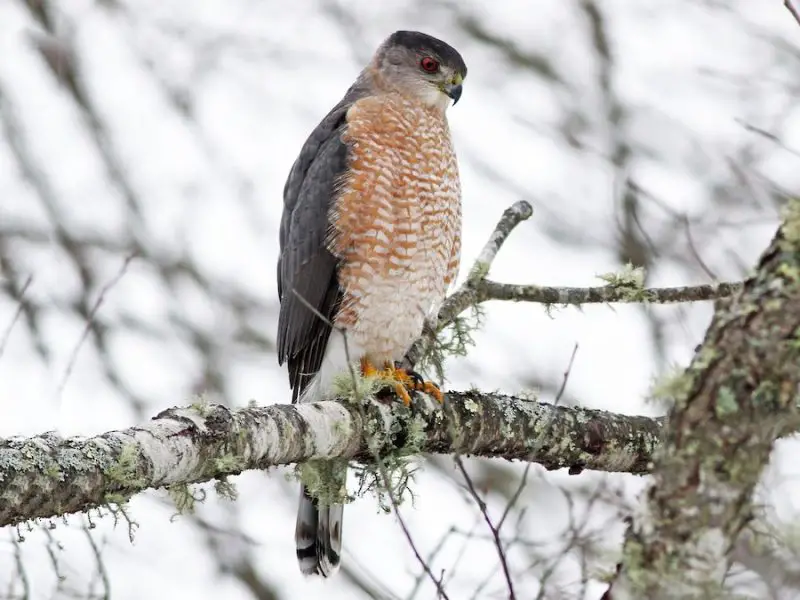
Cooper’s Hawk is a medium-sized raptor known for its fierce hunting skills and stealthy movements through wooded areas. In Utah, this hawk is common in forests and suburban neighborhoods, where it adapts well to human presence and preys on smaller birds near backyard feeders.
It can be identified by its blue-gray back, reddish-barred chest, and rounded tail with dark bands. Compared to similar species like the Sharp-shinned Hawk, Cooper’s Hawk has a larger head that projects well beyond its wings in flight. Their flight is characterized by several quick wingbeats followed by a short glide.
Cooper’s Hawks are seen in Utah throughout the year, though they are most frequently observed during migration and breeding seasons. Interestingly, this species is known for being highly agile, capable of chasing prey through dense branches and trees with incredible speed and precision.
Sharp-shinned Hawk (Accipiter striatus)
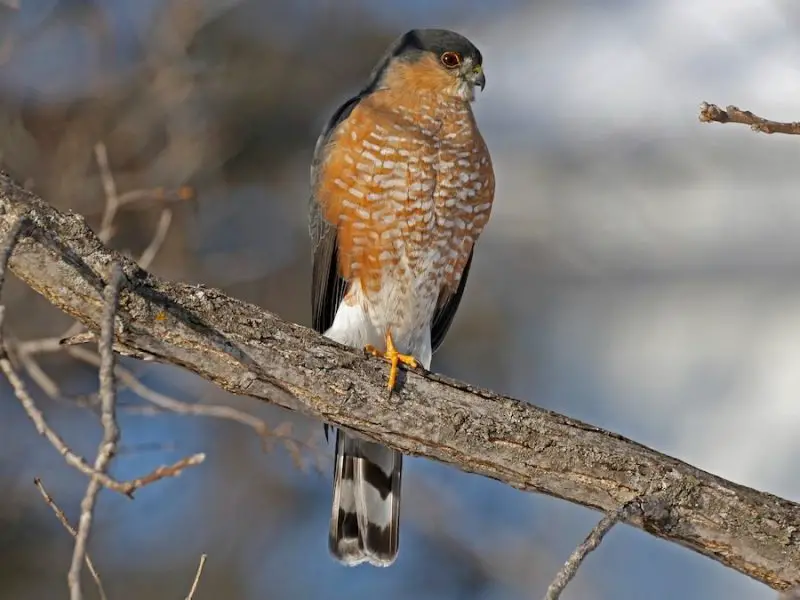
The Sharp-shinned Hawk holds the title of the smallest hawk species in North America. It is a secretive and quick-moving predator that often zips through forests and backyards in pursuit of songbirds. In Utah, it is typically spotted during migration seasons or winter months.
Adults have a bluish-gray back, orange barring on the chest, and a squared-off tail with a narrow white tip. They can be tricky to distinguish from Cooper’s Hawks, though Sharp-shinned Hawks have smaller heads and thinner legs. Their flight is fast and low, often with a series of rapid wingbeats followed by a glide.
Sharp-shinned Hawks are commonly seen in Utah during fall and spring migration as they pass through the state on their way to breeding or wintering grounds. A remarkable fact is that despite their tiny size, these hawks can take down prey nearly their own size thanks to their speed and sharp talons.
Northern Goshawk (Accipiter atricapillus)
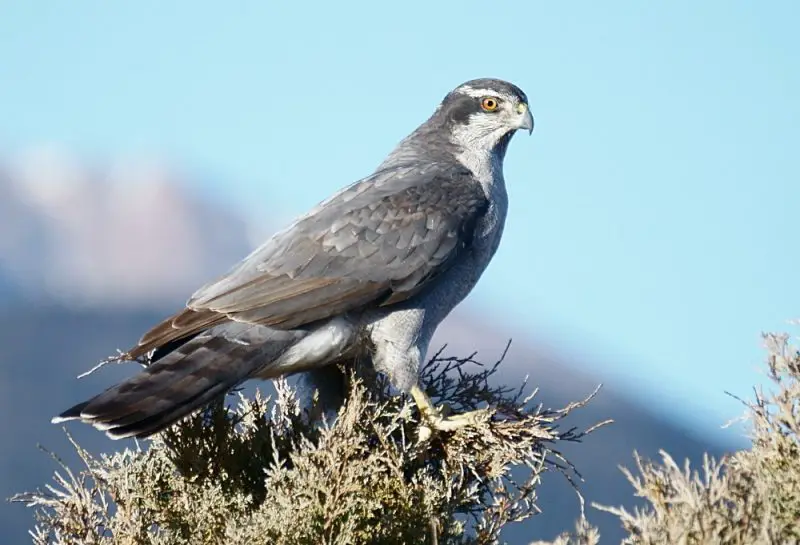
The Northern Goshawk is a large and powerful raptor that prefers remote mountain forests, making it a rarer sight in Utah. This elusive species is the largest of the Accipiters and is occasionally spotted in the higher elevations of the Wasatch and Uinta mountain ranges.
It features a slate-gray back, pale underparts with fine barring, and a bold white eyebrow stripe above its piercing red eyes. Its size and strength allow it to take down relatively large prey, including rabbits, squirrels, and even other birds. The goshawk’s robust build and broad wings make it well-suited for maneuvering through dense forests.
Northern Goshawks are usually seen in Utah during the breeding season in alpine or mature conifer forests. They are known for being fiercely territorial and will aggressively defend their nests, even against humans. In medieval times, goshawks were highly prized in falconry for their strength and hunting ability.
Swainson’s Hawk (Buteo swainsoni)
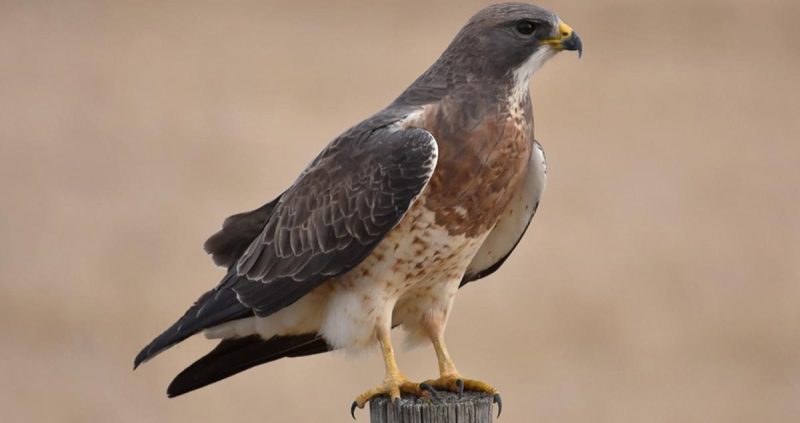
Swainson’s Hawk is a long-distance migratory raptor that spends its summers breeding in Utah’s open grasslands, agricultural fields, and deserts. It is a common sight during late spring through early fall, often perched on fence posts or soaring over flat terrain in search of prey.
This hawk can be identified by its long, narrow wings and relatively slender build compared to other buteos. Adults typically have a dark chest, pale underparts, and a brown or reddish bib across the upper breast. In flight, the dark flight feathers contrast sharply with the pale inner wing, giving it a distinctive two-toned appearance.
Swainson’s Hawks migrate in large flocks to South America for the winter, traveling thousands of miles in one of the most impressive migrations of any raptor. During breeding season in Utah, they mainly feed on insects like grasshoppers, but will also hunt rodents and reptiles to feed their young.
Ferruginous Hawk (Buteo regalis)
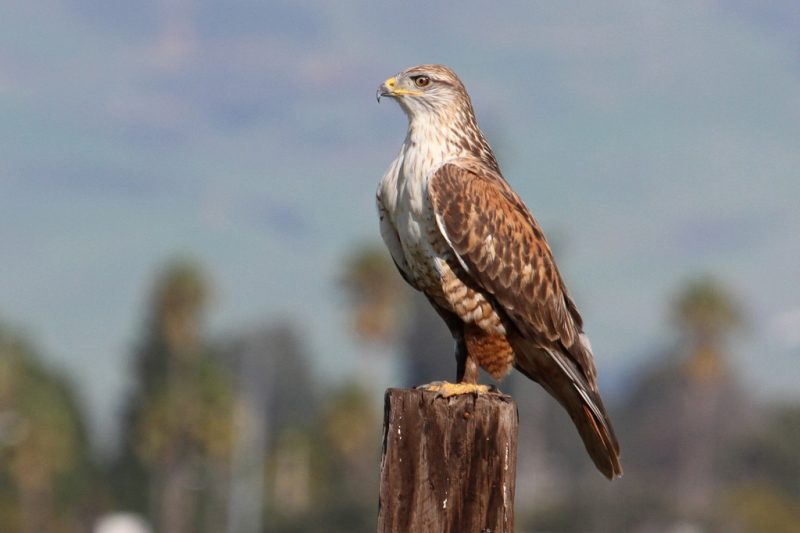
The Ferruginous Hawk is the largest hawk species in North America and is found in Utah’s open rangelands, deserts, and prairies. This majestic raptor prefers expansive, treeless areas where it can hunt for ground-dwelling prey such as rabbits and prairie dogs.
It is identified by its large size, broad wings, and pale coloration. The most common morph has a rusty-colored back and shoulders, a light underside, and feathered legs—a trait shared only with the Rough-legged Hawk. There is also a dark morph with chocolate-brown plumage. Both have a characteristic V-shaped wing profile in flight.
Ferruginous Hawks are year-round residents in parts of Utah, though some individuals migrate south in winter. A fascinating fact is that their name comes from the Latin word ferrugo, meaning “rust,” referencing the reddish hue of their feathers. These hawks often nest on cliffs, trees, or even on the ground in remote areas.
Rough-legged Hawk (Buteo lagopus)
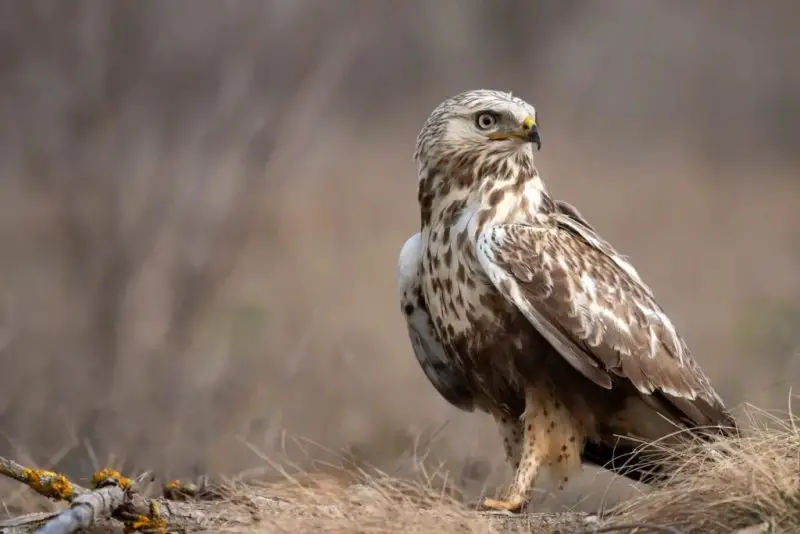
The Rough-legged Hawk is a winter visitor to Utah, traveling south from the Arctic tundra to escape the harsh northern cold. It inhabits open fields, deserts, and farmlands during the colder months, where it hunts small mammals like voles and mice.
This species is unique among hawks for having feathered legs all the way down to the toes, an adaptation for cold climates. It has a light-colored underside with dark patches at the wrists and a broad black belly band. The tail is white with a dark terminal band, and both light and dark morphs exist.
Rough-legged Hawks often hover in place while scanning for prey, a behavior rarely seen in other buteos. In Utah, they can typically be observed from November through March. Their calm demeanor and tendency to perch in exposed locations make them a favorite among birdwatchers in winter.
Northern Harrier (Circus hudsonius)
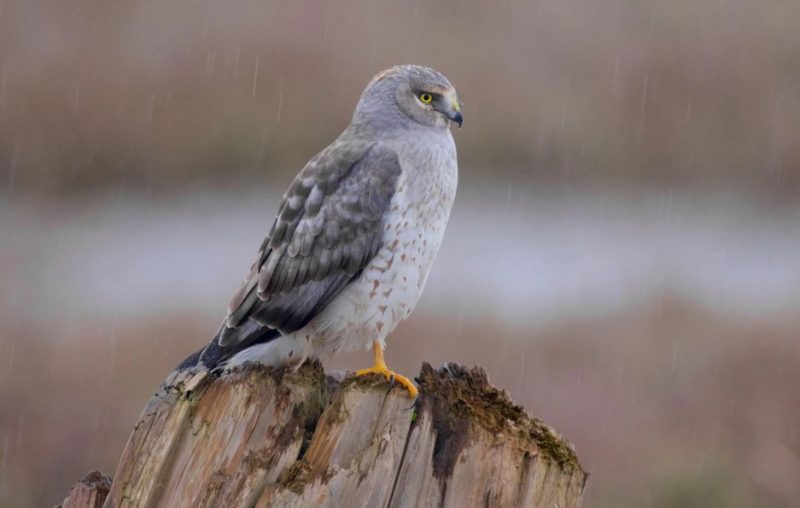
The Northern Harrier is a slender, long-winged hawk frequently seen gliding low over Utah’s marshes, wetlands, and open fields. It is a ground-nesting raptor that is particularly active during spring and fall migration, though it can also be seen throughout the year in some areas.
Adult males are pale gray with black wingtips, while females and juveniles are brown with streaked underparts. All Northern Harriers have an owl-like facial disk that helps them hear the movements of their prey in dense vegetation. A key field mark is the bright white patch on the rump, visible in flight.
Northern Harriers hunt by flying low and slowly just above the ground, using both vision and hearing to locate small mammals and birds. Unlike most hawks, they rely heavily on auditory cues when hunting, a trait more typical of owls. This behavior, along with their graceful flight style, sets them apart from other Utah raptors.
Rare or Accidental Visitors
These hawks are infrequently observed in Utah, often during migration or due to unusual dispersal
Broad-winged Hawk (Buteo platypterus)
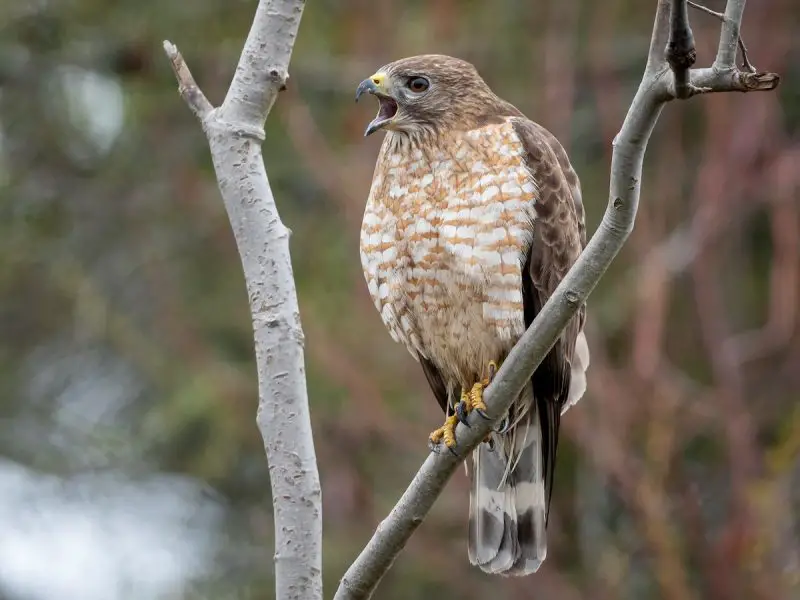
The Broad-winged Hawk is a small, compact raptor that is rarely seen in Utah, primarily during migration. These hawks breed in eastern and central North America and are most commonly spotted in Utah in spring or fall when young birds or strays wander outside their typical range.
Adults are identified by their reddish-brown heads, barred underparts, and a short, banded tail with broad black and white stripes. In flight, they display broad wings with a pointed tip and a strikingly pale underside. Their compact, stocky appearance distinguishes them from other migratory hawks.
One of the most remarkable features of Broad-winged Hawks is their tendency to migrate in large flocks called “kettles,” sometimes numbering in the thousands. Although such events are rare in Utah, birders occasionally spot them passing through during peak migration periods, especially near mountain ridgelines.
Red-shouldered Hawk (Buteo lineatus)
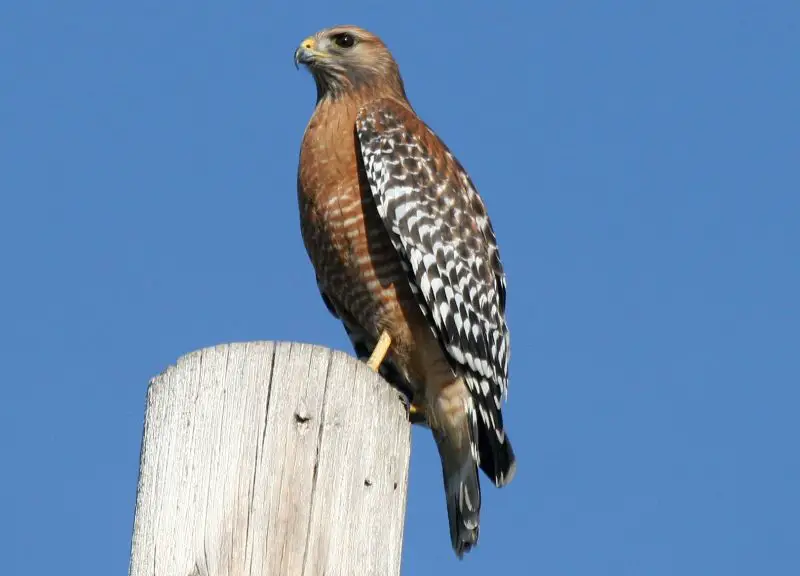
The Red-shouldered Hawk is a beautifully marked raptor with reddish chest barring and distinctive black-and-white checkered wings. It is a forest-dwelling hawk that is seldom seen in Utah, though it may appear during migration or unusual dispersal events.
This hawk is best identified by its rufous shoulder patches, rounded wings, and strongly banded tail. Its call—a loud, slurred “kee-aah”—is a common sound in its core range but is rarely heard in Utah. When it does appear, it is typically around riparian woodlands or forest edges.
Red-shouldered Hawks are more commonly found in the eastern U.S., as well as parts of California. Utah lies far outside their usual breeding territory, but young birds may wander westward. Despite their rarity in the state, their striking plumage and piercing call make them memorable when encountered.
Zone-tailed Hawk (Buteo albonotatus)
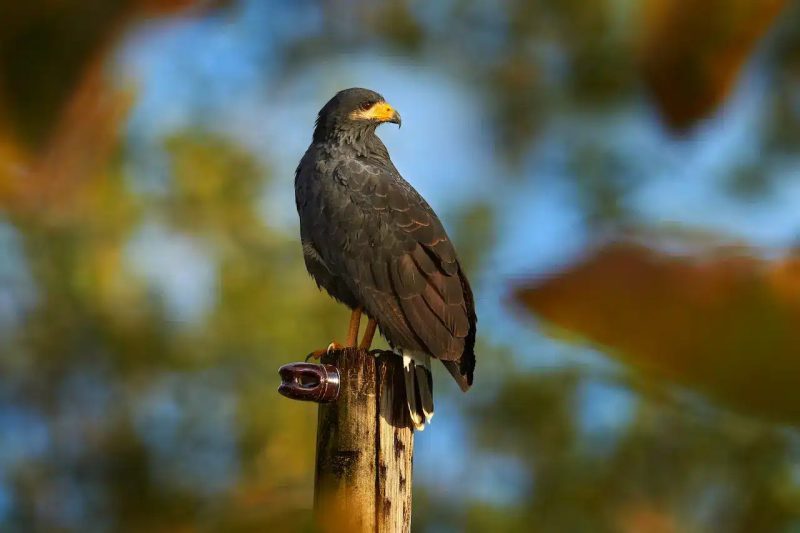
The Zone-tailed Hawk is a dark, elegant raptor with a strong resemblance to a Turkey Vulture in both appearance and flight style. It is an uncommon visitor to Utah, occasionally seen in the southern part of the state, particularly near canyons or desert cliffs during migration or dispersal.
This hawk is mostly black with a pale, banded tail—hence the name “zone-tailed.” In flight, it holds its wings in a shallow V and rocks side to side, mimicking the flight pattern of a vulture. This resemblance may help it sneak up on prey by avoiding alarm.
Zone-tailed Hawks are usually found farther south in Arizona, Mexico, and Central America. Their occasional presence in Utah makes them a target species for avid birders. Their deceptive flight and raptor-like build offer a fascinating example of mimicry in the bird world.
Common Black Hawk (Buteogallus anthracinus)

The Common Black Hawk is a large, dark raptor that inhabits riparian corridors in the southwestern U.S. It is a rare find in Utah, typically restricted to the far southern regions such as Zion National Park or the Virgin River basin, where suitable habitat exists.
This hawk has broad wings, a short tail with a bold white band, and overall black plumage with yellow legs and a large hooked beak. It often perches quietly near water, waiting to pounce on amphibians, fish, and crustaceans. Its flight is slow and deliberate, with deep wingbeats.
Though not common in Utah, the Common Black Hawk is a breeding resident in parts of Arizona and New Mexico. Occasional sightings in Utah are often of wandering juveniles or edge-of-range nesting attempts. Its reliance on streamside habitats makes it vulnerable to habitat loss and water diversion.
Gray Hawk (Buteo plagiatus)
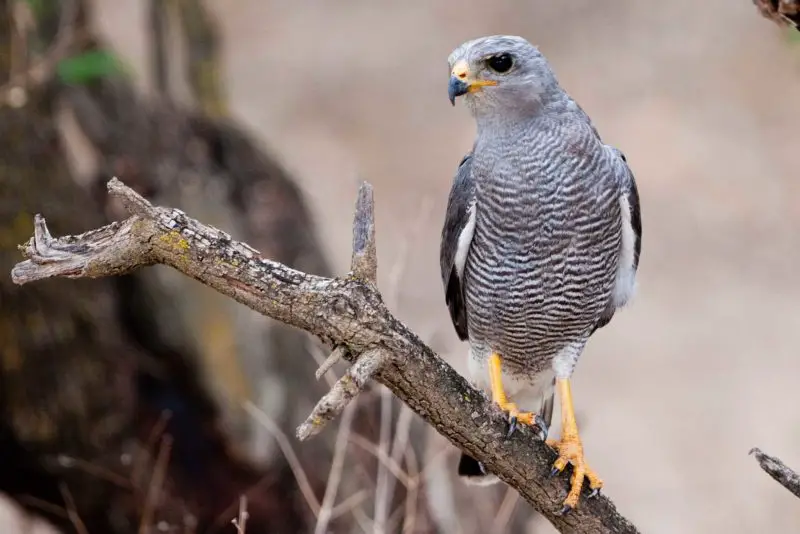
The Gray Hawk is a sleek, medium-sized raptor rarely observed in Utah and typically only as a vagrant. It is more commonly found in the riparian woodlands of southern Arizona, New Mexico, and Mexico. In Utah, it may show up during post-breeding dispersal or along desert waterways in the south.
Adults are a striking pale gray with finely barred underparts and a long tail featuring narrow white bands. Juveniles are brownish with streaked underparts and banded tails. They are graceful flyers, often soaring with flat wings and a slight dihedral.
Gray Hawks specialize in hunting small vertebrates, especially lizards, from low perches. While their presence in Utah is very limited, any sighting is considered noteworthy and often draws attention from birders hoping to spot this rare and elegant hawk outside its usual range.

